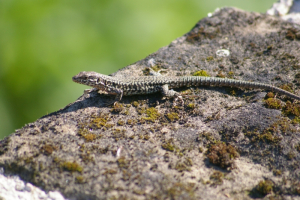Full title: Analysis for the definition of subspecies of the common wall lizards (Podarcis muralis, Laurenti 1768) living in the Grand Duchy of Luxembourg
Abstract
The common wall lizard is a warmth – loving species which is mainly spread in the Mediterranean area. Its northern area of circulation spreads over the north of France, Luxembourg, along the Maas in Belgium, the south of the Netherlands (with the northernmost existing population in Maastricht), scattered appearances in the Eifel area and the Rhine area as far as Bonn. In its northern area of circulation there are probably the following two subspecies: Podarcis muralis brogniardi in the northern Eifel area and the Vennvorland as well as Podarcis muralis merremia at the Rhine and the Moselle.
During the field mapping processes for the “Atlas of Reptiles” of the grand duchy of Luxembourg morphological differentiations came to the attention of the originators. These correspond to the observations and results of the applicant during his dissertation. Accordingly, two subspecies appear to exist in Luxembourg which are only slightly separated in geographical terms, but at the same time both appear at their northern border of circulation. Expansive behaviour of the species is being reported from the Saarland, which has not yet been proven for Luxembourg. If the species behaves expansively in Luxembourg, a bioturbation of the subspecies should occur within a few years. This has to be assumed, because several new habitats have been mapped for the first time between the localities of the Luxembourg – populations with the potential subspecies. A bioturbation of the species would severely exacerbate the differentiation. At present there is still a chance of reconstructing the immigration – route of the species into its northern area of circulation throughout a differentiation of the subspecies.
All of the Luxembourg – populations are being examined morphologically as well as genetically and compared to European reference – populations, thus making an identification of the subspecies possible. Furthermore the routes of immigration of the subspecies in its northern area of circulation are examined. The intended assignment is meant to make a contribution to showing the special importance of Luxembourg for the differentiation of the subspecies of this species.
Status of Phd
Supervisor at university: Prof. Dr. Jobst Meyer, Department of Neurobehavioral Genetics, Psychobiologie, University of Trier (D)
Supervisor in Luxembourg: Edmée Engel, curator, section zoologie des vertébrés, MNHN
PhD granted by Fonds national de la recherche Luxembourg. Duration: 2 years (01.04.2008 – 31.03.2010).
Host institution: Fondation faune-flore @ Centre de recherche scientifique, Musée national d’histoire naturelle.
Contact
Dr. Franz Gassert
Vogelsang 34
D-54292 Trier
Musée national d’histoire naturelle
Centre de recherche scientifique
Laboratoire / Section zoologie des vertébrés
24, rue Münster
L-2160 Luxembourg
phone: (+352) 46 22 33 – 414
Publications and not published works
- Gassert F (2000) Genetische Isolation der Mauereidechsenpopulationen Podarcis muralis (Laurenti 1768) der Stadt Trier. Diplomarbeit. Universität Trier.
- Gassert F (2005) Untersuchung der genetischen Diversität ausgewählter Populationen der Mauereidechse (Podarcis muralis, Laurenti 1768) mit Hilfe der Mikrosatelliten-DNA-Analyse. Dissertation, Universität Trier.
- Gassert F ( 2007) Podarcis muralis. Pp. 30-35 in: Proess R (éd.) 2007. Verbreitungsatlas der Reptilien des Großherzogtums Luxembourg. Ferrantia 52. 58 p.
- Gassert F, Kautenburger R, Müller P (2002) Populationsgenetische Untersuchungen isolierter Mauereidechsenpopulationen (Podarcis muralis Laurenti, 1768) der Stadt Trier. Mitt. Biog. 26: 1-14.
- Kautenburger R, Eisenbarth D, Gassert F, Langer M, Müller P (2001b): Genetic analyses of natural populations in agriculturally used ecosystems in the Trier region. Verh. Ges. Ökologie 31: 271.
- Müller P, Kautenburger R, Elle O, Gassert F, He X, Langer M, Bürger K, TU, N. (2002): Flächennutzungsinduzierte Anpassungsprozesse, molekulargenetische Veränderungen und Indikationsbedeutung von Organismen in der Region Trier als Grundlagen für verbesserte Umweltmanagementstrategien. In: Müller, Rumpf & Monheim (2002) Umwelt und Region. Aus der Werkstatt des Sonderforschungsbereichs 1: 137-142.
- Müller P, Kautenburger R, Elle O, Schmitt T, Eisenbarth D, Gassert F, Langer M, Quack M, Peter T, Rölker T (2002) Veränderungen und Anpassungsprozesse von Tier- und Pflanzenpopulationen in agrarisch und forstlich genutzten Ökosystemen der Region. Ergebnisbericht des Sonderforschungsbereichs 522 – Umwelt und Region: 165-188.
